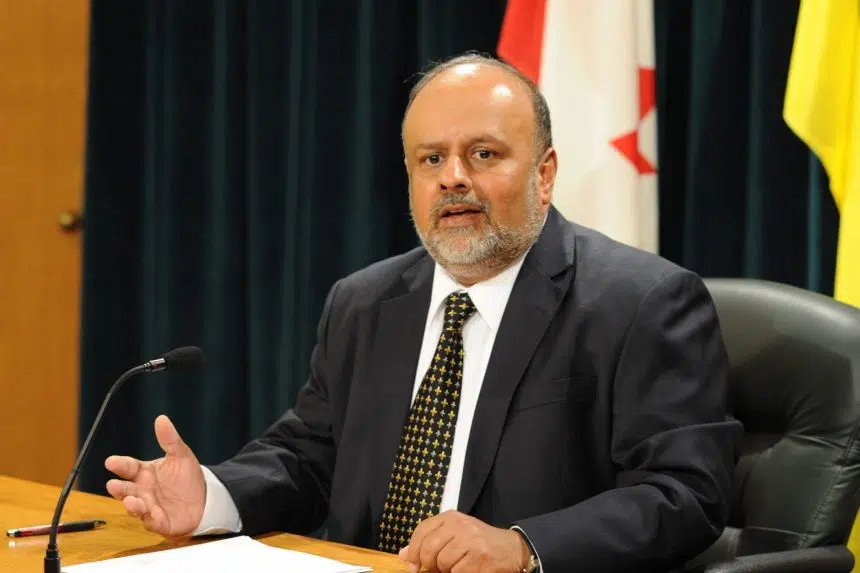Saskatchewan has its second presumptive case of COVID-19.
In a media release Friday, the province said the individual is a resident in their 60s who travelled from Oregon. The test was done in Saskatoon on Tuesday.
The person has been self-isolating at home.
“Public health officials have begun their contact investigation to follow up on anyone who may be at risk of developing COVID-19 because of contact with this individual,” the province said in the release. “If you do not receive a call from public health, you are not at risk of transmission of COVID-19 from this individual.”
The provincial laboratory determined the sample was positive on Friday and forwarded it to the National Microbiology Laboratory in Winnipeg for confirmation.
The province confirmed the first presumptive case on Thursday.
The provincial government also announced new measures in hopes of limiting the spread of the virus.
Starting Monday, no public gatherings of more than 250 people in any one room can take place. That doesn’t include schools, universities or workplaces.
As well, no events of more than 50 people with speakers or attendees who have travelled internationally in the last 14 days can take place.
Stores and faith-based organizations are exempt from those orders, but they must monitor crowd sizes to support safe social distancing.
Starting Friday, people who have travelled outside Saskatchewan in the previous two weeks or who have acute repository or flu-like symptoms shouldn’t visit long-term care homes and hospitals.
The Ministry of Health and the Saskatchewan Health Authority will expand testing capacity for the virus, including the introduction of COVID-19 assessment sites over the coming days.
The government also:
- Prohibited international travel (including the U.S.) for government employees on government business;
- Restricted any out-of-province travel for government employees on government business within Canada;
- Will require government employees who currently are travelling internationally (including to the U.S.) or who plan to travel internationally for personal reasons to self-isolate for 14 days after returning to Canada; and,
- Will require all government employees who are experiencing symptoms of an acute respiratory or flu-like illness to stay home from work.
In an earlier media release, the government said it was addressing the safety of doctors by allowing them to offer “virtual appointments” to patients to halt the potential exposure of physicians and their staff to the virus.
“The new virtual services, which will be supported through a new payment code for physicians, will enable patients to connect with physicians by telephone effective immediately,” the release said.
“The Ministry of Health is also working to provide patients with the ability to connect with doctors by secure video, which may be available as early as next week with physician offices that offer that option.”
The government also announced the budget will be delivered as scheduled Wednesday, but without invited guests in the gallery. As well, all tours and public events at the Legislative Building are suspended and public access to the building also will be suspended.
Schools will stay open as there’s no evidence at this time of community transmission.
Starting Friday, Healthline 811’s capacity was doubled, with more capacity expected.
As these measures are a public health order, they do have teeth.
“We expect that people are going to comply but there are significant financial penalty provisions in the act if it ever came to that,” said Health Minister Jim Reiter.
The province will get about $15.6 million from the federal government’s fund to deal with the virus.
Some of that money will go to things like supplies and expanding testing capacity. Premier Scott Moe said the assessment centres will be opened in communities across the province so that people are able to be tested in a safer way.
Assessment facilities opened in Regina and Saskatoon on Friday and one will open in Prince Albert on Monday.
“Throughout the province, provisions are being made to make it easier for someone to be safely tested, in a timely way, even in a rural setting, by having a primary care site or a health facility during specific hours of the day able to just screen people in a very streamlined way that does not disrupt other care,” explained the province’s chief medical health officer, Dr. Saqib Shahab.
All of these measures are being put in place to slow down the spread of the virus and avoid a rapid ramp up of risk. Moe said the province can’t eliminate the risk, but it’s trying to reduce it.
The measures could be loosened if the situation gets better, but Shahab also warned that they could be tightened if the situation in the province gets worse.
Moe mentioned multiple times that it’s not just on the government to try to stop the spread of COVID-19.
“We cannot leave this effort solely to our health system to react and to respond as new cases may arise. We must take the personal and community responsibility that we know we need to to ensure we are being proactive and preventing the spread of COVID-19 in Saskatchewan,” said Moe.
He repeated messaging that been used all along — encouraging people to wash their hands, practise social distancing, and to self-isolate if they travel or aren’t feeling well.
The Government of Saskatchewan is providing an update on COVID-19 and increased measures being taken by the government.
Posted by 980 CJME on Friday, March 13, 2020











